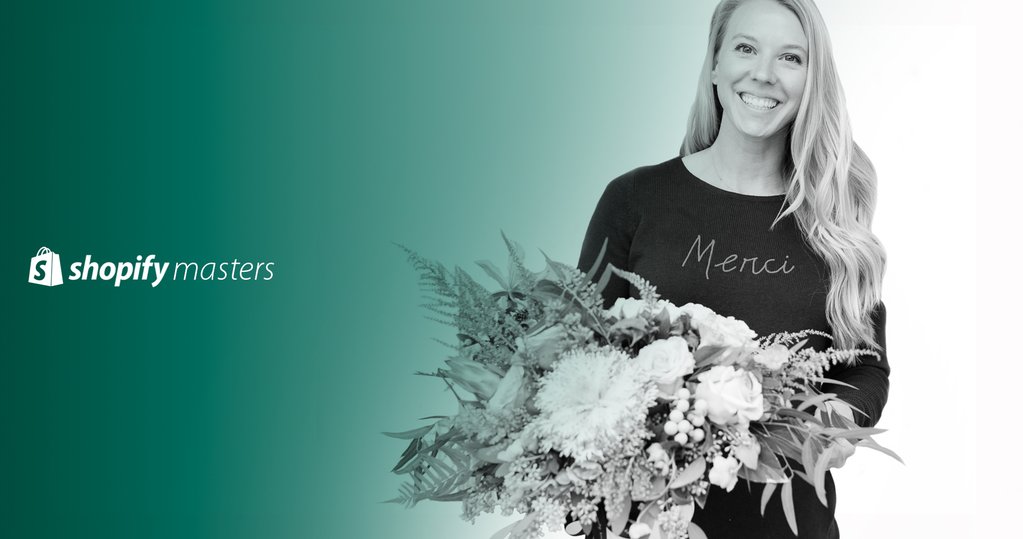While shopping for her daughter’s birthday, Rachel Huntington noticed the limited amount of designs for party supplies. Seeking out non-commercial and more creative partyware, Rachel started Bonjour Fete, a boutique for party goods, tableware, decor and all things event design. In this episode of Shopify Masters, Rachel shares her journey of launching online, operating two physical stores, and building relationships with return customers.
Working in production within the film industry gave Rachel the mentality of anything is possible. With a timely move back to Los Angeles, Rachel expanded her passion for party planning and started to curate supplies for the launch of Bonjour Fete. With 7 figure sales and two retail locations, Bonjour Fete proves that differentiating from the existing market can lead to a market of your own.
Show Notes
- Store: Bonjour Fete
- Social Profiles: Facebook, Twitter, Instagram
- Recommendations: Shopify POS, Wunderlist, Delirious Profit (Shopify app), When I Work (Online Employee Scheduling Software), JustWorks (Payroll Processing)
The search for another world of partyware
Felix Thea: Yeah. So the idea behind this business all started with your daughter's birthday party. So tell us about that party. Like what did you find out during the planning process?
Rachel Huntington: It really kind of came to the forefront of what I wanted to do because I was living in Canada at the time, and if you've ever spent much time in Canada the amount niche stores, they're not as abundant as they are in the States. When it came time for my little girl's birthday, I went to a local store that had party supplies, and everything was matching, like matching princess cups, matching princess plates. It was the same image on 25 things. So I just thought that we could be a little bit more original than that, and really started looking into it and found this whole other world of partyware that existed that I just couldn't find.
Felix: Where did you find this other world of partyware?
Rachel: I was really focused on not finding commercial themes. I wanted to encourage creativity. You see that a lot in kids' toys. They'll have a very commercial themed toy, and then you can also just get plain wooden blocks. And some people just have kids that like to play with the bag that the wooden blocks come in. So I just thought, having some good basics that looked nice and performed well and were stylish; I just couldn't find any.
In the beginning, I couldn't afford to go to a lot of trade shows and research what products were out there. So instead I just followed the trade shows on Instagram and really kind of combed through who they were tagging and what the brands were that they were tagging. I would look in the directory for the trade shows to see who was showing there and then research those companies one by one. It was a long process. It would've been much easier just to walk up and down the aisles of the trade shows. But it was a good way to start without spending much money.
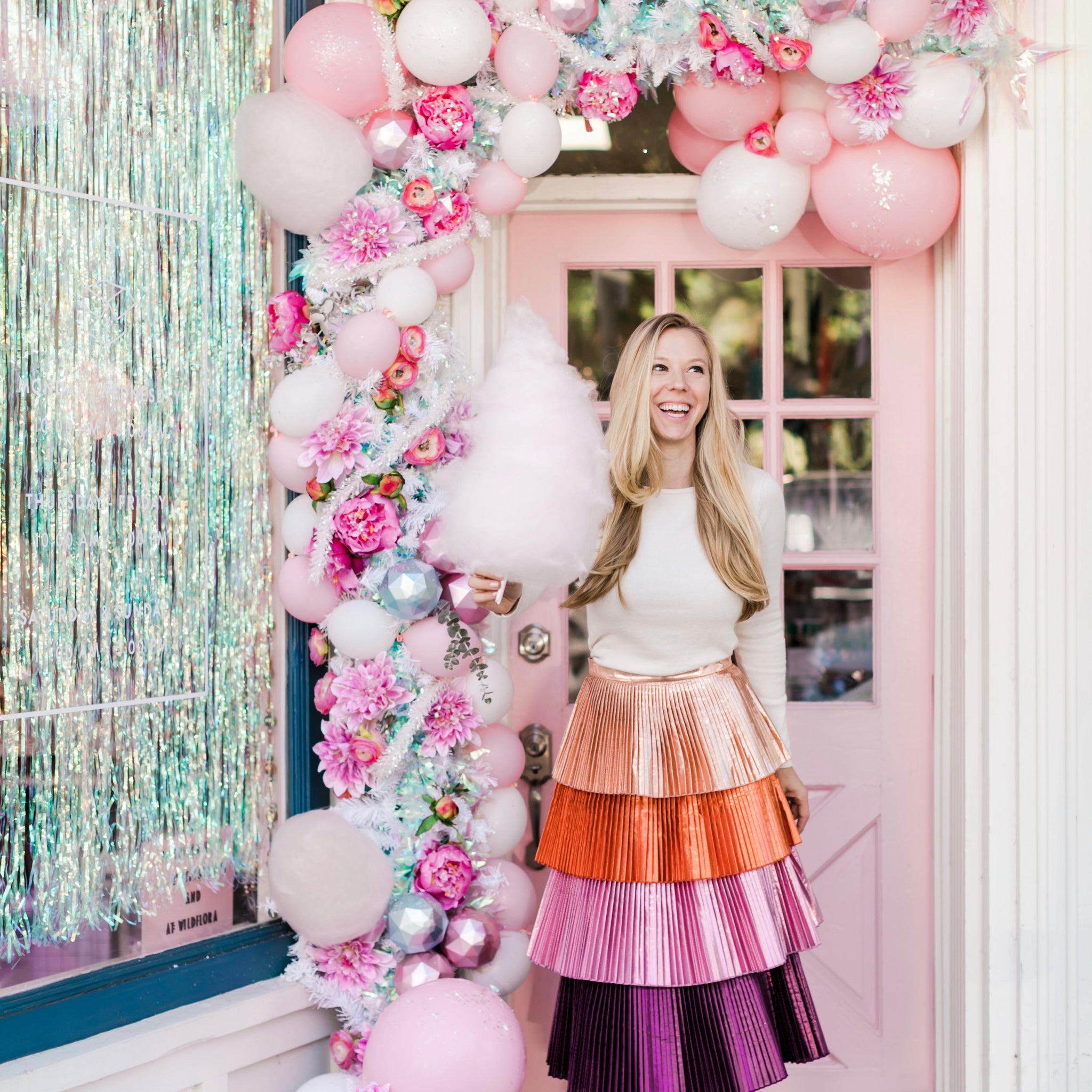
Felix: I like it, that's certainly a lot of entrepreneurial problem-solving. What were the conversations like to get them to do business with you?
Rachel: It was like, "Hey, I saw that you were exhibiting at New York Now. I wasn't able to make the trade show, but I'd love it if you could send me a PDF of your catalog." It was just that on repeat. The information is out there; you've just got to dig for it.
Felix: Were you reaching out to them with the intention of sourcing inventory from them, or were you wanting to know how you can buy this for your own kind of party planning?
Rachel: In the beginning, I was doing it to see if they offered wholesale. When I started in 2014, Etsy was still a giant. And the problem I was finding with Etsy is that you would order something, and it would take like four to six weeks to get because someone was making it in their basement. So it'd be really exciting finding somebody that could do something that could be customized, but sometimes it just took a really long time to get it. Party supplies, there were a ton of part supplies on Etsy and handmade and beautiful ones. But getting a bunch of them at once was quite a challenge. So I just pre-purchased a bunch so that my clients could come to me and find it already made and didn't have to wait four to six weeks for somebody else to make them.
Transfer past experiences into the business
Felix: What was your background before starting this business?
Rachel: I actually started in production at Warner Brothers. When you work as an assistant in the entertainment industry you just learn how to get things done. You never say no to anything. Can't is not an option. So finding things, being resourceful, and making things happen is your everyday task list.
So when I was challenged with finding all these great products while living in Canada, which shipping was difficult to find people that would ship to you, especially small mom and pop shops on Etsy, I just kept going at it. I honed in on a few people that I wanted to carry their line and formed a relationship with them and started hoarding products. That's really how it started. I wanted to throw a great party for my daughter, and I really enjoyed the process of curating. And so at the end of it I had the knowledge of where to get everything, so I said, "Let's do this for my friends, and let's do this for my family and my neighbors." And all of a sudden I'm looking into Shopify.
Felix: So when did this transition happen between service-based business where you're doing the party planning into a product-based business where you're selling the products itself?
Rachel: As anyone knows that orders wholesale, nobody will really let you buy one of the things. Everything has a minimum, and some companies have quite large minimums. I was forced to purchase a certain amount per vendor, and because of that, I had a lot of extras. So it was finding something to do with the extras that really drove the entrepreneurship of the start of this business. In the beginning, we started with party kits. So if you were having a mermaid-themed birthday it'd be cups and plates and napkins and everything altogether in one place so that you could take the guesswork out of it. It was all done for you.
I quickly realized that people liked to decide for themselves what each item was, so I got out of the party box kit very quickly. In fact, at the beginning of my business the company was called Bonjour Fete, and it literally just means Party Box. But I realized that nobody in the US could ever say the word Boite, and it didn't sound great, so Bonjour happened because I was just trying to figure out a word that Americans could say and could recognize, and that was the first one that popped up in my head.
Felix: So during this phase where you are sourcing inventory, what were the first types of supplies that you were stocking and selling on your own site?
Rachel: In the beginning, it was very basic. I had tassel garlands, they're these little handmade tissue twisted strips. Those were really popular. It was very basic. There were maybe 10 themes, and I just tried to curate different products that fell into those categories. But yeah, no, it was pretty basic. Now it's a little different. Now we have almost 9,500 products, different SKUs. It's kind of insane. So obviously it's a challenge to keep track of that, but I know every single product.
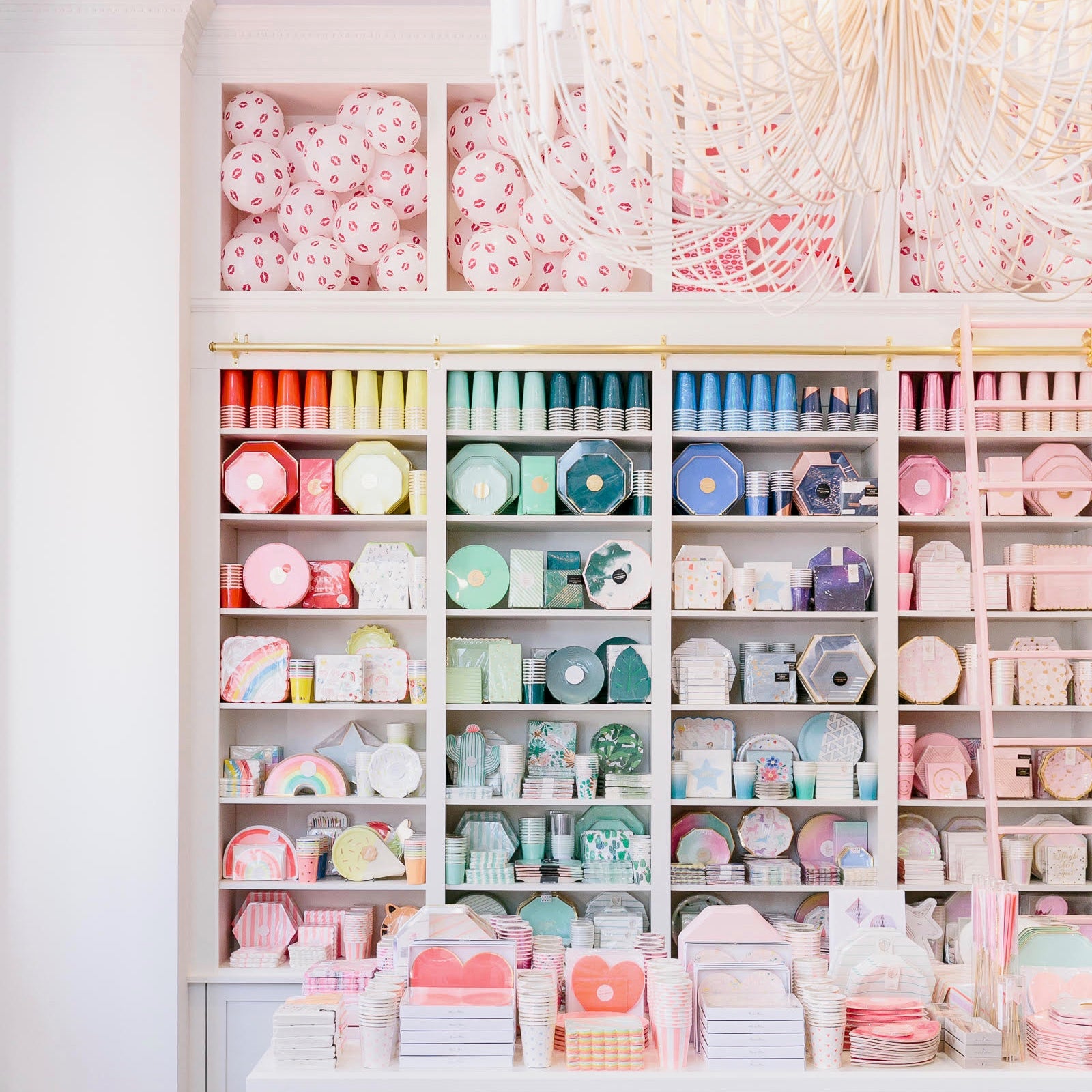
Felix: Before stocking 9,500 products. How did you start off?
Rachel: In 2016, I moved from Montreal back to LA, and that was really when the amount of products kind of took off. I was always limited in Canada with what I could receive and what companies would sell to me. So when my husband's job was done in Canada and we moved back to LA, I had all these products in my basement. And I still have some of the storage containers that they're still in. And we put them on a moving truck, and we brought them out to California. So I want to say we probably have like 40 bins worth just within those themes.
I opened the first retail store, it was talking to clients. I'm never going to be able to compete with the number of products that a Party City has. If you go there, it's a superstore of just partyware. But because of that, people only had that to compare us to. They were used to 50 styles of forks. So at the end of the day, I had to kind of accommodate at least 10% of that, just because it was necessary to grow our business. We had to have a lot of different options.
The journey of entering into retail
Felix: What's the process you follow today to source the inventory?
Rachel: I usually just start with a minimum quantity and try it myself, ask the girls that work in the store what their thought process or what the feedback is on those items. It's trial and error. It's not often that something just doesn't work at all. And the majority of our products are under $10, so there's very little risk in that regard to trying something new. So if I meet somebody that's passionate about their brand, I want to try it.
Felix: What made you decide to open a retail store?
Rachel: I ran out of room in my basement. I had a wall of storage bins. And I just loved it. There was one moment where I said, "Am I actually going to do this? I know nothing about retail. I work in entertainment. This is crazy. This is paperware and partyware." But I think it's because I lived in LA, it's a huge city, and people have parties all the time all year-round. It's not often that there are weather restrictions, and people like to entertain a lot. And it blew my mind that I couldn't find any of this stuff in a retail store anywhere close to me. So it was really searching for like-minded stores and not finding them that I said, "I have to do this. It has to happen."
I think if you knew what it would take to start a business you would never do it, because it's way harder than you can imagine. But I think for me what it was also was I had these customers that were taking the time to go online to pick out their tableware and their decorations for their kid's party or a baby shower or wedding shower, and sometimes I would pack up their orders and it didn't quite all go together. Or I would be like, "Oh man, I wish I could've talked to that person and suggested this, because this is the one thing that this order is missing." And you can't really do that when someone orders something online. You don't want to write them like, "Hey, bad choice. Let me suggest something else." But you can do that in a store. And the fun part about it is that our clients come in, and they grab things off the shelves and they lay it out on our counter, and they see it all together. That was never something that I was going to be able to offer online.
If you're in fashion you want to see people wearing your clothes, and I think if you're in parties it's kind of satisfying to see and hear the stories behind why people are celebrating these events. And they're coming in to buy party supplies because they are celebrating somebody, and there's something very special about that. They're creating memories. They're spending money on somebody that they love. It's not an errand. It's not buying milk or eggs. It's exciting.
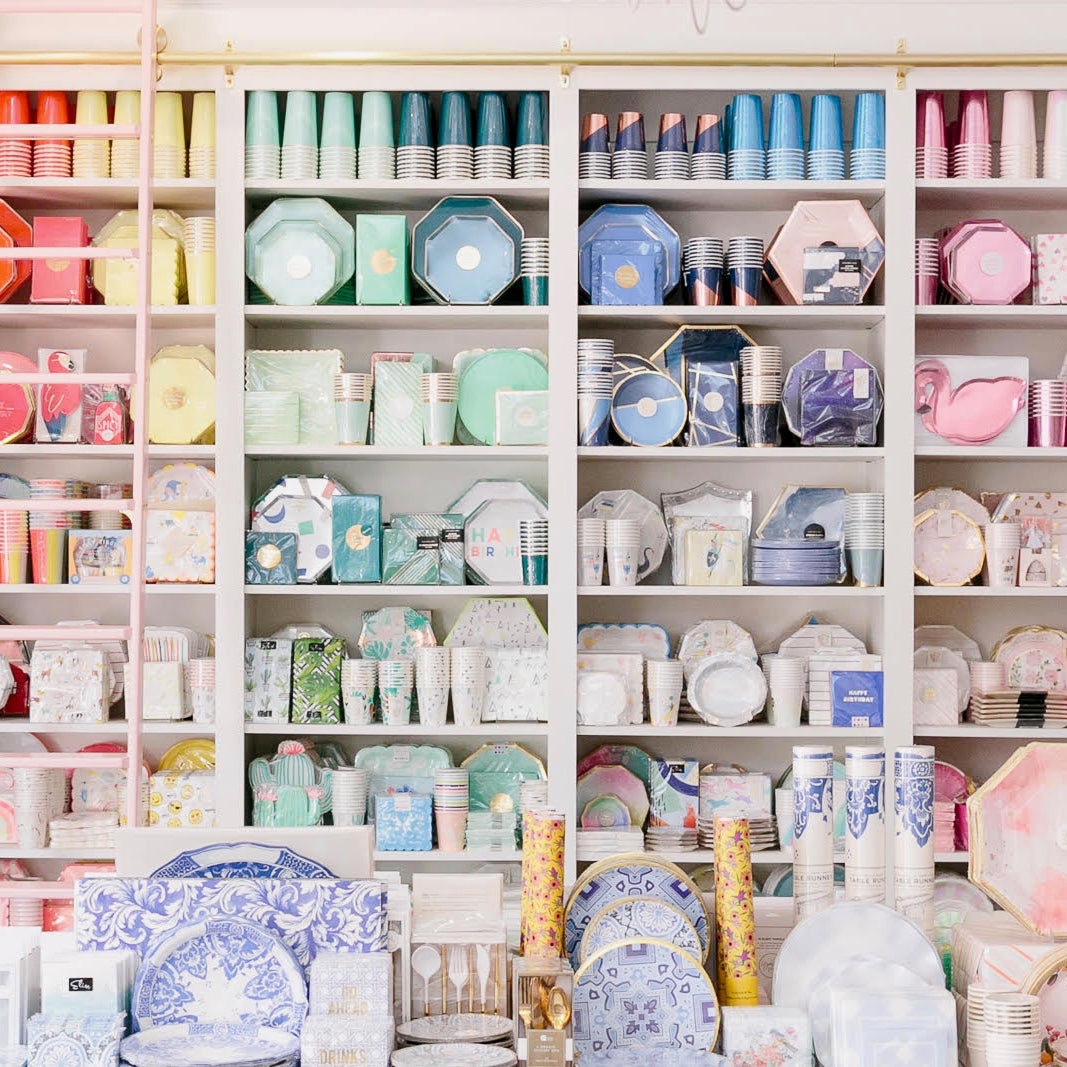
Felix: What were some of the biggest challenges or sacrifices that you had to make for retail?
Rachel: When we started, juggling inventory was quite a challenge, especially the first few months that we opened the retail store and I had a very limited supply on the shelves. Because we were ordering six and twelve of each item, if somebody purchased something online during that day and I didn't pull it from the shelf then it was possible that somebody would come into the store and purchase it. And it happened many times where I would get the ca-ching from Shopify and I would see an online order and somebody was walking around the store with that item in their bag. I was like, "Oh, now I'm going to have to send an email and say, 'Sorry, we're out of stock.'"
Juggling inventory was a big deal, and so was staffing. I am extremely passionate about what I do, and finding people that were equally as passionate is hard in the beginning. And because just taking on additional overhead is so overwhelming when you get started, it was a scary process, knowing that you're already taking on rent and utilities and all these additional expenses. But people were the most expensive and the most worth it. It allowed me to be able to pick up my kid on time and not have to put a 'Back in 15 Minutes' sign on the door.
Felix: When it comes to physical stores, are there different kinds of metrics that you try to pay attention to that gives you a gauge of how well things are going?
Rachel: I like to look at return customers. That's really important to me because it's built on relationships. Ideally, I'm celebrating somebody's baby shower, and then when they have a baby I'm celebrating their kid's first birthday and second birthday. So about one-third of our clients are repeat customers. And I think the benefit that we have there is that all these people are buying our products and then going home and having a party with their friends, the 20 friends. So it only takes a few friends saying, "Where did you get that," to then have people coming back to find you. I think if you're wearing an outfit on the street and one person stops you then you might've been able to tell the one person where you got your shirt. But at a party, you're telling a lot of people. So I think that word of mouth has really helped.
Felix: What were some of the challenges you faced with expanding a physical store?
Rachel: Technically, construction. In the beginning, you're just using existing shelving or items that you can find that weren't necessarily made for you but you make it work. And I think as soon as you expand you need to be deliberate about every inch of your store, especially when you are paying a premium. So the construction and learning how to make fixtures that work for you that are great for display, it was a huge learning curve. And eventually, we landed on certain types of tables and bins that customers like to shop from that make it easy for them and easy for us to clean up and keep organized too because everything has to be organized.
Felix: How do you collect and organize feedback from different customers?
Rachel: We use something called Wunderlist. We have that on our POS system up at the front. When somebody asks for something and we don't have it, it goes in the Wunderlist, and then we'll research it. And eventually, if the same items keep coming up over and over we make it a reality. So especially with two different stores in two different areas of town, when the same thing comes up multiple times we know it's time.
Felix: What were some of the biggest lessons you learned from that first store that you knew you had to nail down before opening that second store?
Rachel: For the second store, we curated it even more. We took all of our best sellers and put those front and center. Our first store is double the size, so we can have more fun and experiment and provide larger quantities, which is why most of our party planner clients in town come to our Studio City store because we just have a lot here. But in Palisades, we are in a development where people aren't necessarily planning a party that is walking in, but maybe they're going to a birthday party. And that kind of drove us in the direction of needing to provide gifts. So all of a sudden, instead of just being party experts we were learning to curate what gifts people were going to parties wanted to bring. That's a huge part, especially in the fourth quarter, gifts.
Felix: How do you balance between online and the two physical stores?
Rachel: I was extremely lucky because about a month before opening the second store the locations feature became a reality in Shopify. I had been following it for probably about a year. There have been rumors that you could add a second location. I was crossing my fingers every day. I actually don't know how we would've done it if that feature hadn't become available. But lo and behold, one day it popped up on my screen. And it is a challenge. When we receive merchandise we have to split it between the stores. It's very time-consuming, but it's necessary for us to have accurate numbers so we know what to order and the quantity and how to track it.
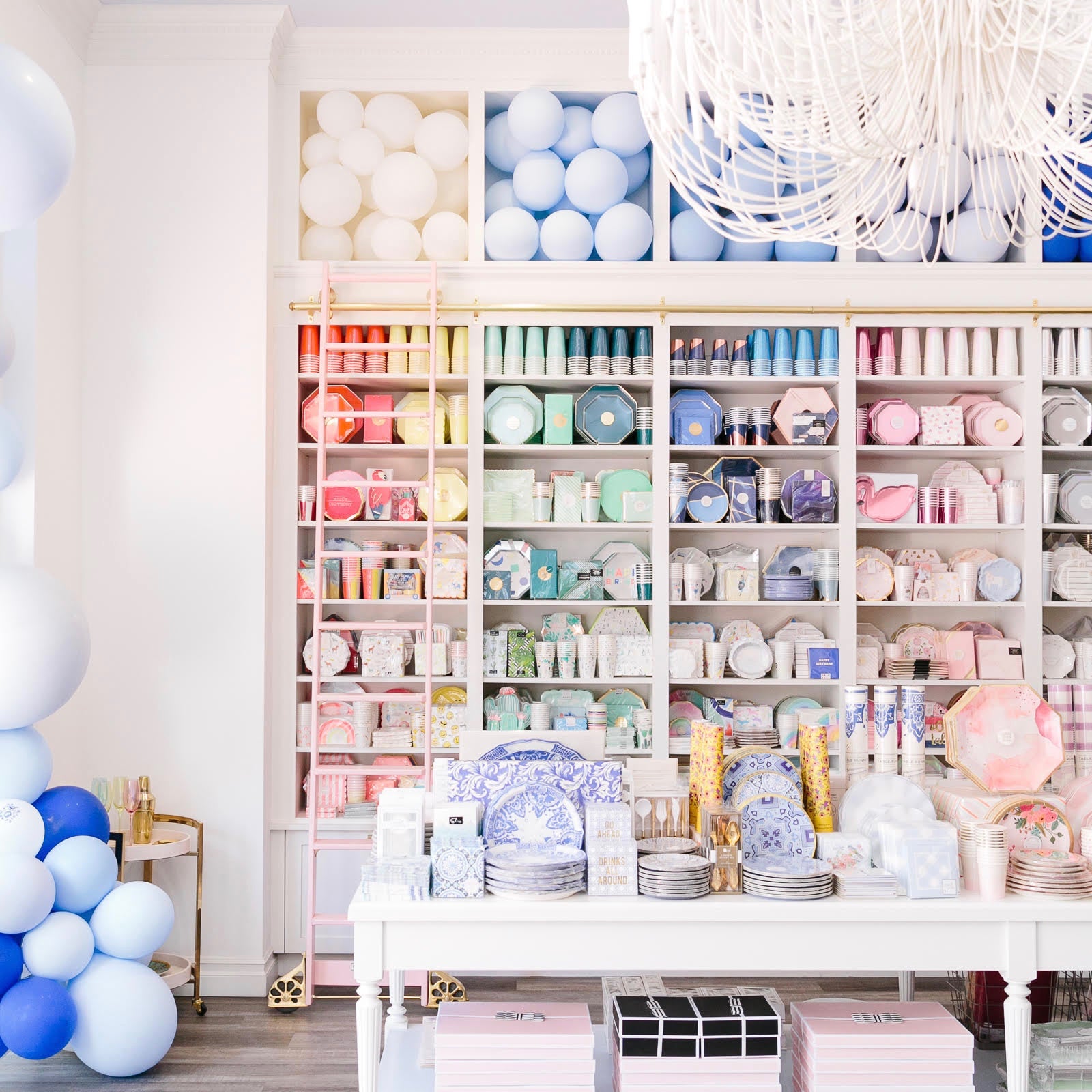
Building an organic online following
Felix: How do you create content on your Instagram in a way that shows off your products?
Rachel: I decided early on not to showcase a lot of parties that my customers were doing or parties that I planned because I felt like they were really personal. They were people's real events. I felt like it wasn't my business to show off their home or what I did in their home specifically. So instead, I decided to do photoshoots of what it could look like. And I understand that it's not always in a realistic setting. I'm in a store early in the morning and have plenty of time to set it up. It's a little different than Saturday morning running around trying to set up a table when your kid keeps eating all the candy off the treats table. I think styled photoshoots were really clutch. I found a photographer that I loved who lives very close by, and we just started scheduling holiday shoots. And every time we get new products we shoot them but as you would use them in a party, not just a clean product shot.
Felix: What about the Instagram story? How do you decide what goes in there versus in the feed?
Rachel: People really like seeing Instagram stories for process pictures and videos. I think that a lot of times they like seeing that my office is filled to the brim in boxes or that we can barely shut our van door because there are so many balloons exploding out of it. They like seeing the good and the bad, and I like sharing the good and bad because it's not always a pretty picture. Sometimes, as fun, as it is to walk into a store and everything's done and sparkly and beautifully presented, it takes a lot of moving and unpacking and pricing and all those things that no one really ever thinks about.
I think seeing people's process makes me more invested in the people. It's nice to know what they were doing earlier in the day and that it wasn't always an easy finished look, that it was maybe a little hectic before the scene was set.
Felix: These are obviously great ways to engage and drive the customers to your store. How do you get people to actually follow your profile? How did you grow your following and get people to see the content in the first place?
Rachel: I think it was really organic. I've never used a service or an app or anything like that, so it was just doing all original content. That's what people like to see. People that were following our account knew that they were going to get original content. It's hard to stay ahead of the trends, and it's certainly hard to try to show a level of perfection at all times through a pretty picture. But just original content, and responding to people's DMs, and responding to the comments. It really just has grown very organically.
Felix: What kind of photography, in particular, worked for you when you started Bonjour Fete’s account?
Rachel: I think showing your products how you would use them. That's what seems to land the most for us. Seeing a blank product picture is not as fun as seeing a product in a party setting. So I do feel like I have a little advantage in that the products are being styled with very colorful other products. Color has definitely been the key to our success. The images just pop out in people's feed because we are selling beautiful decorations essentially.
Apps that help Bonjour Fete to keep on celebrating
Felix: So you mentioned a couple of apps previously. Wunderlist. You mentioned the Shopify locations feature. Are there other apps that you rely on or tools that you really on to help run the business?
Rachel: I'm currently loving an app called Delirious Profit. It really helps me understand my profit margins and how many products I have. And what I like about it is it automatically defaults everything to 50%. So in Shopify right now you have an option to put in a cost price. When I started with Shopify that was not an option. So a lot of our older products I relied on this app to just go ahead and put it at 50%. It wasn't always 50%, but at least we were starting off at a percentage that was close to what it was. So Delirious Profit I really love. Our store schedules and time-off requests and availability and all that stuff, we use a company called When I Work, and it's really great. The girls can clock in and clock out that way. And I get sent a chart, and it makes it super easy to see, "That person is continuously late."
Rachel: When I Work is great for scheduling, especially with two stores. It really makes it easy to make sure that you're covered. And then the last one that I really like is a company called Justworks, which does payroll processing and has HR benefits, which they've made it so much easier.
